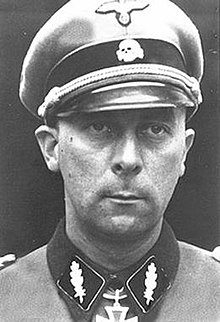
Back Wilhelm Mohnke Afrikaans Wilhelm Mohnke AN فيلهلم مونكه Arabic فيلهلم مونكه ARZ Вилхелм Монке Bulgarian Wilhelm Mohnke Catalan Wilhelm Mohnke Czech Wilhelm Mohnke German Wilhelm Mohnke Spanish ویلهلم مونکه Persian
Wilhelm Mohnke | |
|---|---|
 Mohnke as SS-Standartenführer in 1944 | |
| Commander of the 1. SS Panzer Division Leibstandarte Adolf Hitler | |
| In office 20 August 1944 – 6 February 1945 | |
| Preceded by | Theodor Wisch |
| Succeeded by | Otto Kumm |
| Personal details | |
| Born | 15 March 1911 Lübeck, German Empire |
| Died | 6 August 2001 (aged 90) Barsbüttel, Germany |
| Awards | Knight's Cross of the Iron Cross German Cross in Gold War Merit Cross |
| Military service | |
| Allegiance | Nazi Germany |
| Branch/service | Waffen-SS |
| Years of service | 1931–1945 |
| Rank | SS-Brigadeführer und Generalmajor der Waffen-SS |
| Commands | 1. SS Panzer Division Leibstandarte Adolf Hitler Kampfgruppe Mohnke |
| Battles/wars | World War II |
Wilhelm Mohnke (15 March 1911 – 6 August 2001) was a German military officer who was one of the original members of the Schutzstaffel SS-Stabswache Berlin (Staff Guard Berlin) formed in March 1933. Mohnke, who had joined the Nazi Party in September 1931, rose through the ranks to become one of Adolf Hitler's last remaining general officers at the end of World War II in Europe.
Mohnke participated in the fighting in France, Poland and the Balkans as part of the 1. SS Panzer Division Leibstandarte Adolf Hitler. In 1943 he was appointed to command a regiment in the 12. SS Panzer Division Hitlerjugend. He led the unit in the Battle for Caen, receiving the Knight's Cross of the Iron Cross on 11 July 1944. Mohnke was given command of the Leibstandarte Adolf Hitler division during the Battle of the Bulge in December 1944.
While participating in the Battle of Berlin, Mohnke commanded Kampfgruppe Mohnke (Combat Group Mohnke) and was charged with defending the government district, including the Reich Chancellery and the Reichstag.[1]
He was investigated after the war for war crimes, which included allegations that he was responsible for the killing of prisoners in France in 1940, Normandy in June 1944 and Belgium in December 1944. Although Mohnke served 10 years in Soviet custody, he was never charged with any crimes, and died in 2001, aged 90.
- ^ Fischer 2008, pp. 42–43.